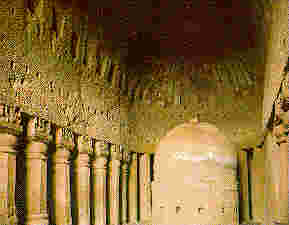
|
_____________________
__________________________________________________________________
_________________________________________________
The process that led to the creation of the Brahmin caste had its corollary in the formation of the Kshatriya caste. The Kshatriya caste was formed due to the gradual establishment of a monopoly on military training and the art of warfare by a section of the people of the casteless Vedic Ganas (tribes).
 | The The Buddhist religion was founded by a Kshatriya - Prince Siddhartha later known as Gautama Buddha. In spite of his royal (and military) background, the Buddha, preached the message of peace and non-violence and preached against observing caste distinctions. Seen here is a Chaitya (Buddhist Prayer hall) in the Ajanta Cave temple complex. |
The formation of the Kshatriya caste could also have followed a similar course of evolution in the Vedic society of the Aryans. To begin with the Aryans, like people, all around the world, lived in tribes that roamed from place to place in search of game and pastures. In the earlier period of human history, the role Of the forces of nature was decisive in the lives of men.
In these circumstances every tribe could barely acquire food, thru hunting gathering. etc ., which was only adequate for survival. As human power to produce was at a very low level there could hardly be any accumulation of wealth. The tribe's collective effort was only enough to sustain its members and all that was produced was instantly consumed. Thus in the absence of any accumulation of wealth (surplus) there existed no possibility of one tribe attacking another with the object of grabbing the other tribe's accumulated wealth - as there was no such accumulation. It was even purposeless to capture able bodied members of other tribes with the aim of making them work, as such captives could only join in the tribe's collective activity of hunting and gathering. Thus the labour of such captives was only enough to produce food for the captives' own survival, it created no surplus which members of the victorious tribe could take away.
Thus under these circumstances there was no logic behind raiding other tribes to take captives for this purpose. Although tribal warfare did take place continuously, the reasons were either to capture women or to capture men who would be eaten. The fact that cannibalistic practices did exist among Aryan tribes is proved by the ritual of the Purusha-Medha Yagna, in which such captured members of other tribes were originally butchered and eaten. The idea of cannibalism in society would appear gruesome and unbelievable, but we have an anecdote which clearly indicates to the fact that cannibalism should have existed among Aryans at some stage.
 | The people of Kalinga had nourished a martial tradition through the ages. In ancient times, even Samrat Ashoka Maurya had to battle Kumar, the king of Kalinga, before he could complete the unification of India. In the middle ages too, Kalinga (modern Orissa) was the only part of the country with Assam, that successfully resisted Muslim rule all through. Seen here is the Mukteshwar temple at Bhubaneshwar which represents an evolutionary style in Kalinga architecture that was to reach its zenith in the Konark Sun Temple. The Sun temple is also a monument to a military victory. |
Symbolic Cannibalism? - The Story of Chilaya (Srilaya)
This is the story of Chilaya who was fortunate in two respects - he was born in a royal family and his parents were deeply religious. The prince Chilaya grew up under the care and affection showered on him by his parents. His father had a charitable table disposition apart being a devout person. His fame as a ardent worshipper of Lord Shiva spread far and wide. So much so that even Lord Shiva came to hear about it.
To test the integrity of his worshipper Shiva took upon the guise of a hermit and one early morning knocked on the palace doors asking for alms. The King was very pleased on seeing a hermit at his door and asked him to demand whatever he wanted. To the King's horror the hermit coolly asked for being served human meat for his meal, and that meat was to be nobody else's but prince Chilaya's. The very idea of their only son Chilaya being sacrificed to satisfy the quaint hermit came as a whiplash to the devout God-fearing parents.
But a guest that he was, the hermit's demand could not be turned down, and the idea of deceiving him by offering him some other meat was not one which the sincere couple could entertain. Ultimately they gave in to that ghastly demand and arranged for Chilaya to be sacrificed to feed the hermit.
But the emotional stress for Chilaya's mother was too much and she arranged for her son's head to be preserved with the intention of asking the Gods to revive it later. But the wily hermit saw the absence of the head in the meat served to him and demanded that it be given to him if his host expected him to touch the food. Reluctantly, the heartbroken mother presented Chilaya's head to her unrepentant guest and while doing so burst into hysterical sobs.
As the wily sage, who was no other than Lord Shiva himself, knew that his disciples had passed his severe test and thereupon revealed his true form. On recognizing that the Lord himself stood before them, Chilaya's parents fell at his feet and on being asked by the Lord for any boon, they naturally asked for their son. Shiva asked them to call out their son's name. The stupefied parents did so and to their amazement the food they had placed before their guest disappeared and the son Chilaya descended from the heavens and stood before them.
This story is a fableized recollection of cannibalism amongst the Aryans. Had it not been so it need not have been incorporated into a legend that was supposed to be believed by lay people.
The Purusha-Medha Yagna also suggests the cannibalism theory which could have logically existed in a society where the labour of a person was only enough for his own sustenance and left no surplus product which could be taken away by another person. In this scenario, it was logical that captured prisoners of war were killed and even eaten. But with the rising productivity of human labour, consequent to the use of better implements, domestication of fire, smelting of metals, etc., it became possible for the first time, for humans to work not only for their own sustenance, but also to leave a surplus which was over and above the immediate consumption needs for sustaining themselves. This surplus took various forms like, implements, cattle, slaves and later on of precious metals.
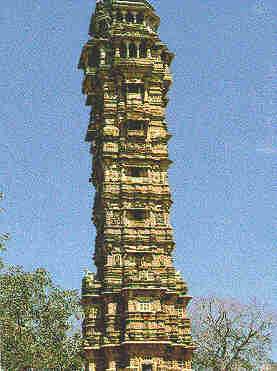 | The Kirti Stambha at Chittodgad in Rajastan represents a tribute to the military prowess of the Rajput Kshatriyas of Mewad. These Lions of Mewad defiantly held aloft the banner of Indian Independence during the darkest days of Muslim tyranny. |
Now it became logical to raid another tribe for capturing able-bodied males and females with the intention of converting them into slaves and making them work. These slaves worked not only to sustain themselves, but with the rise in human productive capacity, they could also produce a surplus which was not necessary for their own sustenance and which could hence be taken away by their masters. With rise in this productive capacity, the Purusha Medha Yagna also underwent a change in Aryan Society.
Purusha-Medha Yagna - A Symbolism for Human Sacrifice and Cannibalism?
As described in Vedic literature during the Purusha Medha Yaqna the captured men were not to be killed, they were only to be tied to a stake and a piece of burning wood was to be waved before them and they were then set to work. This ritualisation clearly reflects the fact that originally the Purusha-Medha Yagna could have been a human sacrifice, whose nature was changed to suit the altered circumstances wherein captured men from other tribes could be put to better use rather than their being eaten.
Even the Ashvamedha Yagna sacrifice underwent a change with the rise in productive capacity and the possibility of grabbing the surplus wealth of other tribes. Whereas originally in the Ashwamedha Yagna, the horse was killed to be roasted and eaten, in later times and the ritual did not remain a sacrifice, except in name. The horse was now not killed, but was decorated with the King's emblem and was set free to roam at will, and the regions through which this horse passed came under the rulership of the kinq who had performed the Ashvamedha Yagna. In case any other king stopped the horse; a war ensued and the victorious king annexed the defeated kin's territories. Thus the Ashvamedha Yagna also changed from being a simple act of killing a horse for consumption, to being a medium for the grabbing of land and property of adjoining kingdoms - a form of nascent imperialism.
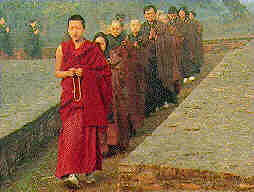 | The Buddhist religion preached against observing caste distinctions. The Buddhist order was open to all castes and nationalities. Hence it spread to many parts of the world. Many Christian values are derived from the older Buddhist tradition. See here are Buddhist monks proceeding towards the prayer hall in the temple complex at Bodh Gaya. |
The Ashvamedha in Ramayana
The following anecdote from the Ramayana illustrates the role of the Ashvamedha sacrifice. As we know Shri Ram, the eldest son of Dashratha the King of Ayodhya was banished for fourteen years from his kingdom due to the machinations of his step mother Kaikeyi. In exile Rama's wife Sita is kidnapped by the Demon King Ravana and to liberate Sita from Ravana's clutches, Rama had to raise an army with the help of the monkey King Hanuman. After a fierce battle in Lanka which was Ravana's capital city, Sita is rescued.
On returning from Lanka after the said fourteen years period was over, Rama was crowned king of Ayodhya.
But the people of Ayodhya knew that Sita had been imprisoned by Ravana and some of the meaner of the populace doubted Sita fidelity. On one occasion when Rama had hosted a grand banquet at his palace one of the women servants had to stay overnight at the palace to oversee the arrangements for the banquet. When she returned home the next morning, her husband was furious with her for having stayed overnight at the palace. In a fit of rage he drove her out of the house saying that it may be possible for Rama to accept a wife who had stayed at another person's house but he himself would not do so. Thus saying he banged the door of house on his wife's face. The sobbing woman went to Rama and pleaded her case. On hearing her tale Rama was aghast and after introspection he decided that if his acceptance of Sita was causing problems for his subjects he should part company with Sita whose fidelity was under a cloud for his subjects. Next day a reluctant Lakshman took Sita out of Ayodhya and left her at Sage Vishwamitra's hermitage in a nearby forest.
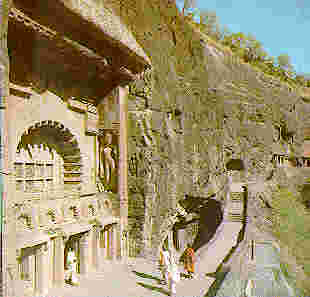 | The Buddhist tradition represented a counter tendency against the ever growing caste distinctions. Many Hindu Kings patronised Buddhism. Seen here are the Ajanta caves constructed in the reigns of the Chalukya, Rastrakuta and Yadava kings in the middle ages. These temples represent the hewing of a temple complex from a whole range of rocky hills. |
At that time Sita was in the family way, and in the course of a few months she delivered two bonny twins who were named Luv and Kush. The boys grew up amidst love and affection showered by their mother but they never came to know who their father was. They had of course heard the glory of the King of Ayodhya but did not know that the King was their father. Then one day they heard that there was to be a great occasion in the city of Ayodhya where the King Rama was to perform an Ashvamedha Yaqna. They too wanted to witness the Yagna and without anyone' s knowledge they slipped out of the ashram (hermitage) and came to Ayodhya.
When they saw that besides the King there was an image of a lady, they enquired with the townsfolk as to the reason for this. On hearing the tale of the expulsion of Sita, whom they did not know to be their own mother, they were aghast and decided that they would give battle to Rama by capturing the Ashvamedha horse.
When the horse was passing by their Ashram (hermitage), the two teenaged boys captured it and challenged the shocked army of Rama which was following the horse. A fierce battle ensued and many of the soldiers were slain, but the two boys were unhurt. When Rama came to hear of this he sent his brother Lakshman to avenge this. Lakshman too was hurt. On hearing this Rama himself came to offer battle but before this could happen the sage Vishwamitra intervened and told Rama as well as Luv and Kush their true relationship.
Thus finally the family reunion took place and the separation caused by one person's expressing doubts about Sita's fidelity was bridged due to an Ashvamedha Yagna. Although the Yagna did not bring new territories to the King of Ayodhya, Rama nevertheless got back his two sons,
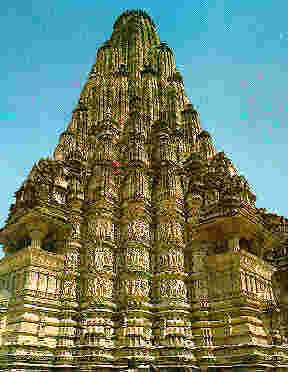 | Many Hindu Kings erected awesome temples to commemorate their victories. The Ashwamedha and the Rajasuya Yagnas which they performed were a symbol of their military prowess. Seen here is a magnificent spire (Shikhara) of one of the Khajuraho temples in Central India. These temples are among the most majestic Hindu temples in India.They were constructed by the Chandella Rajputs who ruled Central India and resisted the first Muslim invasions in the 10th century. |
This episode shows how the Ashvamedha Yagna had become a medium for territorial expansion from it original purpose of being a simple act of ritually killing and eating a horse. The basic reason for this change was the rise of productive power of human labour, leading to surplus wealth which could be accumulated and also looted. This surplus was in the form of human captives who could be enslaved, cattle, and grains and was now an object of accumulation.
_________________________________________
Now we move on to examine the process that led to the status of Kshatriyas as Protectors of Cows and Brahmins.
_____________________________________________________________
_____________________________________________________________________________________
|
|
_ _ _ |
View My Guestbook
|
_______________________________________
_________________________________
